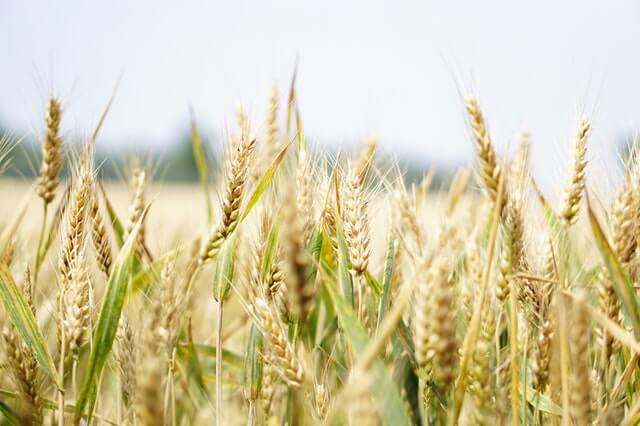Author: Tina Grech, Senior Nutritionist, Alltech Lienert Australia
As many people would know, a La Niña event has been declared in Australia in 2020. The last major La Niña occurrences were in the summers of 2010/11 and 2011/12, and they resulted in 2010 to 2012 being Australia’s wettest two-year period on record. Although a wet Spring will usually result in above-average grain yields, it can also result in downgrading of some grain to feed grade due to weather damage.
There are a number of considerations that must be taken into account when assessing the suitability of weather affected grain for stock feed, which may range from slightly stained to shot/sprouted or even mouldy grain. Although it can never be considered a fool-proof method, an initial visual assessment can be done by inspecting grains for signs of sprouting or mould damage.
These may include:
- Discolouration of grains (pink to white or black to grey)
- Visible moulds
- Musty/mouldy smell
- Visible shoots and/or roots
- Swollen, soft or split grains
Visual assessments alone are often not sufficient to determine the extent of weather damage to the grain. Obtain records for the test weight, falling numbers and moisture levels of the grain, as these can be indications of weather damage. Grains should be tested for Energy (DE or ME) and both grains and legumes should also be tested for protein. In addition, be wary of Heliotrope (Potato Weed) contamination in late harvested grain, as well as Native Vetch (Tares) which are both very toxic and may germinate due to the wet growing season.
Mycotoxin testing can also be done, and Alltech’s 37+ Mycotoxin Analysis considers the mycotoxin challenge as a whole, rather than looking at the individual mycotoxins present. Utilising the most advanced mycotoxin detection technology available (LCMS/MS), ALLTECH 37+® provides producers with a more accurate picture of mycotoxin contamination. It shows how likely it is to impact their animals’ health and performance through tailored, species specific risk assessment reports and recommendations.
We are also excited to announce that we will soon have Alltech Rapiread™ available in our Roseworthy office. This provides rapid mycotoxin testing results, in-depth analysis and real-time recommendations. It is relevant for individual raw materials and forages and can test for up to 3 different mycotoxins such as Aflatoxin, DON and Zearalenone. The rapid mycotoxin test kits provide accurate and reliable results in 30 minutes by embracing new technologies and innovations. By providing actionable advice backed by data, we can now help you make more informed decisions to help mitigate the threat of mycotoxins.
Minimising the risks:
Regular grain testing – Mix together multiple samples over different areas of the paddock or truckload to obtain a representative sample for testing. Test both protein and energy to obtain a comprehensive assessment of your grain.
Purchasing – To help ensure the quality of your grain supply this season, look to purchase grain to Silo standards. There are no standard maximum levels of sprouting for feed grade grains, so be sure to negotiate this with your seller prior to purchase. Be careful buying grains which have been stored for a long period of time.
Storage – A cool, dry storage space will help to reduce mould growth, insect infestation and sprouting. Weather damage causes the seed to deteriorate much faster, so try to store grain for as short a period as possible. Knowing your grain usage requirements and arranging contracts to suit may help to minimise on- farm storage time.
Diet formulation strategies:
Protein sources – Generally when we have a good finish to the growing season, we find that although the energy and test weight of the grain is good, protein levels are usually lower. Therefore, an increase in the dietary levels of legumes and protein meals may be required to help meet the protein and specific amino acid (protein building blocks) requirements and maintain productivity.
NSP/Phytase enzymes – Non-starch polysaccharide (NSP) enzymes, which breakdown the anti-nutritional NSPs in grains are an excellent way of improving feed efficiency and increasing the grains nutritional content. Similarly, Phytase enzymes also increase the grains nutritional value by breaking down the strong Phytate bonds present in grains. The LA Enzyme Complex Farmpack is a multi-active enzyme containing both NSP and Phytate enzymes and are strongly recommended to include in every pig and poultry ration.
Mycotoxin binders – In years such as this, most livestock producers include Mycosorb A+ in their diets as an insurance against moulds in the grain, many of which are undetectable by a visual assessment alone.
Feeding Mycosorb contributes to managing the control and the impact of mycotoxins.
More information on Alltech Mycotoxin Management can be found here: /our-solutions/mycotoxin-management/
Please contact your sales representative or nutritionist to discuss grain quality, testing for moulds and specific information on tackling mycotoxins in your feed.

